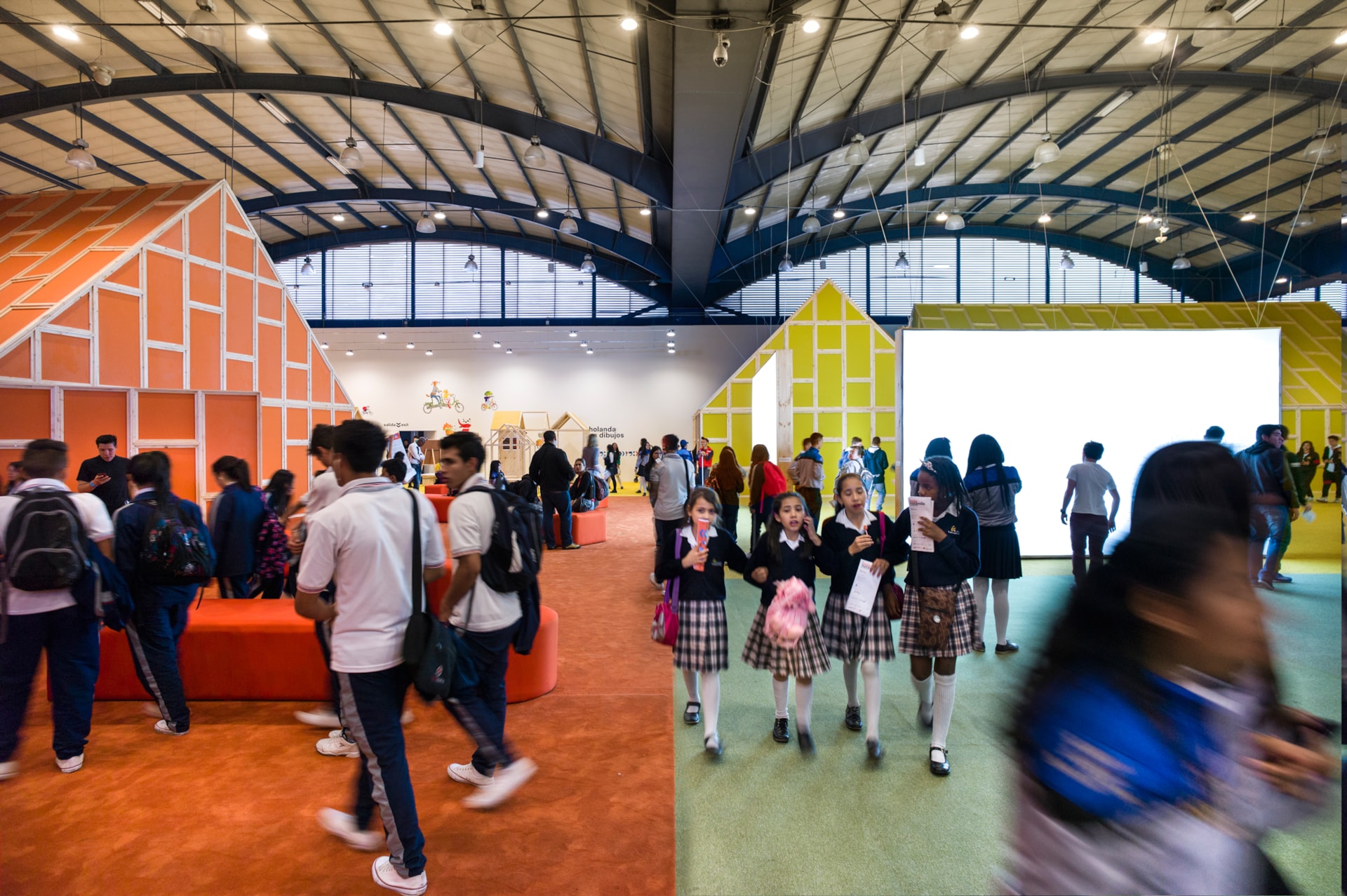.jpg)
Hola Holanda
The Netherlands 2016 pavilion for the Bogotá Book Fair (FILBO) showcases and celebrates Dutch design and literature. Rather than creating a one-time setup with the consequent waste of resources, MVRDV designed a modular system of crates to create a village of pavilions that will be reused as libraries in neighborhoods around Bogota. In this way the lifetime of the pavilion is extended and the spirit of the Book Fair is kept alive.
- Location
- Bogotá, Colombia
- Status
- Realised
- Year
- 2015–2015
- Client
- FILBO
- Programmes
- Educational, Temporary, Exhibition
- Themes
- Architecture, Public, Culture
Every year FILBO, regarded as one of the most important trade events in Latin America invites a guest country to host the main pavilion. 2014 saw a display of Peru’s culture and literature, and last year was dedicated to the late Colombian author, Gabriel García Márquez, where his fictional country of Macondo became the ‘guest nation’. This year the Netherlands, and MVRDV, were invited to host the pavilion and take part in a knowledge and culture share with Colombia. The exhibition, designed in collaboration with Dutch designer Irma Boom and the Dutch Embassy in Colombia, opened its doors to an expected 500,000 visitors giving them an immersive experience in Dutch design, literature and culture. As well as Princess Laurentien of the Netherlands who opened the pavilion, notable Dutch writers such as Cees Nooteboom, Tommy Wieringa and Herman Koch were also at the event presenting their works.
MVRDV looked to re-imagine concept of temporary pavilions and set the goal to create a legacy for FILBO that would feed back into the communities of Bogotá. The event is hailed as a major cultural, and financial, boost for the country and region, but the pavilions and exhibitions themselves tend to serve their purpose and then disappear. To challenge this and help promote education and literature throughout Bogotá, pavilions within the Dutch exhibition are constructed of uniquely designed wooden crates that can be easily deconstructed and reassembled in any number of combinations. Once the event is over, these pavilions will be distributed throughout Bogotá to provide social and education spaces, as well as libraries, for communities throughout the city.
The catalogue of pavilions which includes a tribune-come-meeting-block, circular book shop and exhibition room are all built up from over one thousand wooden crates, and are each vividly coloured depending on its respective theme. The crates epitomise the Dutch design method of simple functionality combined with practical economics and complete adaptability. Each unit is cut from standardised wooden panels, leaving as little waste material as possible and are constructed in such a way that provides unlimited possibilities for reconstruction throughout their lifetime.
“Our design is a village, an accessible, democratic design for all, executed in the best Dutch spirit with some fun.” Says MVRDV founding partner Jacob van Rijs. “But it was important also to comment on the trade fair system. Instead of trashing an expensive pavilion after a short use we wanted it to be reused adding long term value to the city.”
Furniture for the exhibition was a result of collaborations between Dutch designers and Colombian craftsmen. At the heart of FILBO is the aim to spread the knowledge of local and international writers, for MVRDV this idea translated into the architecture and design of the exhibition as well; to export the Dutch know-how and combine this with Colombian craftsmanship. Not only does this maximise on the budget, but more importantly it creates an experience that is more a partnership than an individual display. Dutch designer Irma Boom inspired locally crafted punctuation-styled furniture for the exhibition, as well as the graphical design, signage and the image throughout the exhibition. Whilst designer Richard Hutten exported the idea of his famous book-chair to be made with a Colombian twist.
The exhibition gives a glimpse into everything Dutch; the landscape, polder society, design approach, history and ambition; whilst focusing in on five main aspects of Dutch society. An explosion of colour marks each experience with its own array of vivid carpets and furnishings; reminiscent of Curacao, the Dutch-Caribbean island known for its iconic hybrid aesthetic. A tulip covered flower-house installation sits outside for visitors to admire before they are guided through the great gate entrance into the exhibition village. Inside, the Dutch personalities zone looks at the life and works of visual artist Jan Rothuizen, poet and writer Hendrik Marsman, and historical figure Anne Frank. Dutch design showcases the Super Models exhibition, a travelling collection of miniature models of design and furniture. As well as this are pavilions on transport, modern Dutch literature and book design.
The tribune houses an auditorium, a Dutch author’s space as well as areas for press and business meetings and can be wrapped in a huge curtain to isolate the space for events and presentations. Visitors will be able to recharge at the Dutch bar, that spills out into the central meeting space of the Plaza Holanda in front of the tribune. At the end of the experience is the book store, in which 1500 individual Dutch titles, translated into Spanish, will be sold.
The pavilion is the result of the collaboration between MVRDV, the Netherlands Embassy in Bogotá and the designer Irma Boom and local architect Carlos Medellín from El Equipo Mazzanti and was supported by Desso, Philips, Vescom and Brand & Van Egmond.
Gallery
.jpg?width=1920)
.jpg?width=1920)
.jpg?width=1920)
.jpg?width=1920)
.jpg?width=1920)
.jpg?width=1920)
.jpg?width=1920)
.jpg?width=1920)

.jpg)
Credits
- Architect
- Principal in charge
- Partner
- Strategy & Development